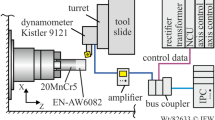Abstract
This paper presents a novel concept to enhance the conventional combination machining ‘turning and grinding’ by a long-stroke honing process for finishing bores of axisymetric parts. Honing is the best choice when the surface integrity of tribologically highly-stressed parts is of vital importance. The presented approach reduces the required overall machining time when compared with that of the conventional machining sequence on separate machine tools, and also enhances the production accuracy through a single clamping setup. The fundamental details like tool design, infeed strategies and possible process-chains of the developed approach for honing on a combination machining center are explained. Experimental results of two different process-chains are analyzed: Firstly, the ‘turning-grinding-honing’ (TGH-chain), where honing is conducted after the grinding process; and secondly, the ‘turning-honing’ (TH-chain), where honing is applied directly after the rough turning. The experiments showed promising results for the applied position-controlled infeed strategy of the developed long-stroke honing process regarding the production efficiency.








Similar content being viewed by others
References
Johlen G (2003) Prozessoptimierung für die Hartfeinbearbeitung durch Kombination von Hartdrehen und Schleifen. Dissertation, Universität Dortmund
Klocke F, Brinksmeier E, Weinert K (2005) Capability Profile of Hard Cutting and Grinding Processes. CIRP Ann Manuf Technol 54(1):557–580
Weck M, Brecher C (2006) Werkzeugmaschinen–Konstruktion und Berechnung. 8. Auflage. Springer, Berlin-Heidelberg
Marschalkowski K (2006) Honen auf Kombinationsmaschinen. Seminarunterlagen zum 2. Dortmunder Schleifseminar, ISF, Universität Dortmund, S. X-1 bis X-10
Biermann D, Weinert K, Paffrath K, Marschalkowski K (2007) Honen auf Kombinationsmaschinen—Ein alternatives Werkzeugkonzept. Zeitschrift für wirtschaftlichen Fabrikbetrieb (ZWF) 102(9):531–535
Biermann D, Weinert K, Marschalkowski K (2009) Langhubhonen in der Kombinationsbearbeitung–Werkzeug- und Prozessentwicklung für das Bohrungshonen. Zeitschrift für wirtschaftlichen Fabrikbetrieb (ZWF) 104(9):755–760
Haasis G (1995) Grundlagen und neue Techniken beim Langhubhonen von Bohrungen. Handbuch zum VDI-Seminar „Hochleistungstechnologien in der Feinbearbeitung“, Düsseldorf, 2./3.5
Tönshoff T (1970) Formgenauigkeit, Oberflächenrauheit und Werkstoffabtrag beim Langhubhonen. Dissertation, Universität Karlsruhe
Flores G (1992) Grundlagen und Anwendungen des Honens. Vulkan Verlag, Essen, ISBN 3-8027-2904-8
Inasaki I (1985) Monitoring of dressing and grinding processes with acoustic emission signals. CIRP Ann 34(1):277–280
Sporer A (2006) Hohe Sensibilität entwickeln. WB Werkstatt + Betrieb 3, Carl Hanser Verlag, München, pp 35–37
Sporer A, Spitzer M (2008) Das Ohr am Schleifprozess–Neue Lösungen zur Prozessüberwachung beim Innenrundschleifen.WB Werkstatt + Betrieb 1–2. Carl Hanser Verlag, München
Mushardt H (1986) Modellbetrachtungen und Grundlagen zum Innenrundhonen. Dissertation, TU Braunschweig
Langenstein P (2005) Verbesserung der Bearbeitungsqualität beim Zahnradhonen durch Optimierung der Hauptspindelantriebsdynamik. Dissertation, TH Zürich
Acknowledgments
This research project has been supported by the FWF (Forschungsvereinigung Werkzeugmaschinen und Fertigungstechnik e. V.) in the context of the project FWF 1307 titled “Honen auf Kombinationsmaschinen”.
Author information
Authors and Affiliations
Corresponding author
Rights and permissions
About this article
Cite this article
Biermann, D., Marschalkowski, K. & Paffrath, KU. Development of a honing process for the combination machining of hardened axisymmetric parts. Prod. Eng. Res. Devel. 4, 147–155 (2010). https://doi.org/10.1007/s11740-010-0223-8
Received:
Accepted:
Published:
Issue Date:
DOI: https://doi.org/10.1007/s11740-010-0223-8




